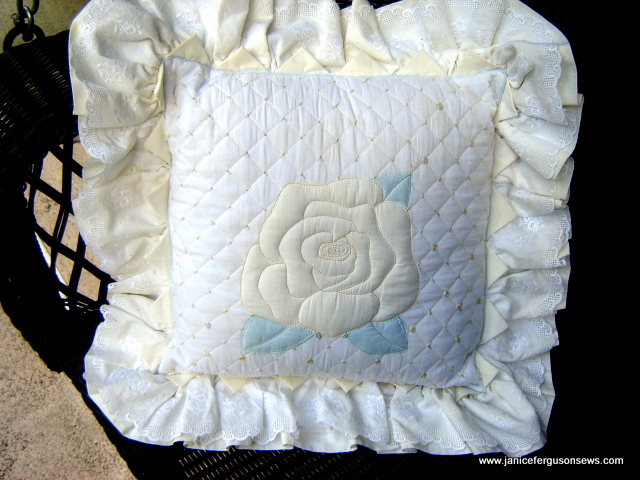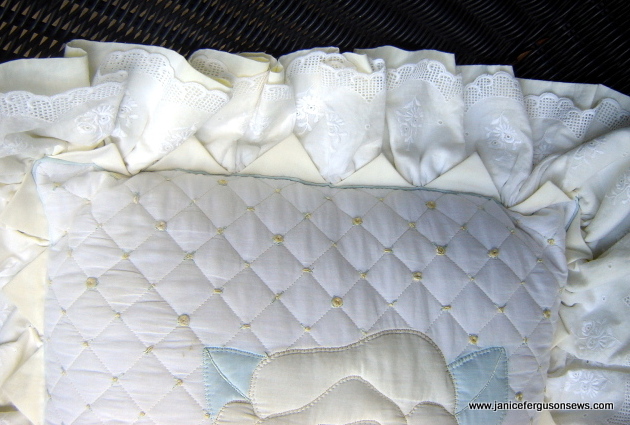But she loves it and asked me if she could have it when she is grown up. I expect she will own it long before that.
Featured in an article in the Heirloom Quilting series I wrote for Creative Needle magazine. Portions of that article are included in this post. In order to keep this post to a reasonable length, I have left out detailed instructions for piping, sharks’ teeth and the ruffle.
~~~~~~~~~~~~~~~~~
The yellow rose pillow features Swiss batiste, silk threads, Swiss embroidered trim, hand embroidery, shark’s teeth and shadow appliqué. All of the quilting was done by machine.
The rose and leaves are shadow appliquéd. With this technique, a piece of colored fabric is placed under a sheer foundation. The color which shadows through is a muted shade, rendering a look similar to that resulting from shadow embroidery. Usually, clear colors work best, making it less likely that the colors will appear muddy.
Trapunto is a time honored method of adding extra padding beneath selected components of a quilt to give extra loft. On this pillow, it was done with an innovative, time saving, method developed by Hari Walner, well-known quilt artist and author. In her award-worthy book, Trapunto by Machine, she details this procedure.
Her method employs the unique features of water soluble thread. A layer of high or extra loft batting is placed beneath the selected portion of the pre-marked quilting design, in this case, the rose. Then, with the water soluble thread in the needle and regular thread in the bobbin, the outline of the rose is straight stitched. The excess batting is cut very close to the stitching line.
Next, the entire marked pillow top is placed over a low-loft batt and the quilt backing. After basting the three layers together, the rose is outlined again with decorative thread and a straight or decorative stitch.
After the pillow top was quilted and all embellishments had been worked, the piece was immersed in water to rid it of the water soluble thread and all markings.
~~~~~~~~~~~~~~~~~~~~
When the pillow top was completed, it just did not look finished to me. So at each intersection of the cross hatching, I embroidered a yellow flower, composed either of a French knot, a cluster of 3 or 5 French knots, a pinwheel rose or a bullion rose. Using a variety of yellow shades added interest to the embroidery.
With green silk floss, a leaf or leaves were stitched at each yellow embroidered flower. The same color green floss was used throughout, though the style of leaf varied.
Note: At the base of the shadow appliquéd leaves are bullion knots. While their design value is questionable, they were necessary to cover a hole cut in the pillow top when trimming away the batting.
Laurel was not yet born when I made this pillow. If heirlooms are made and meant to be enjoyed by future generations, this yellow rose has fulfilled its legacy.



